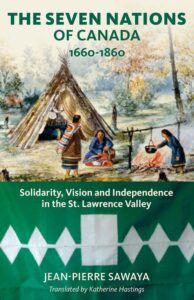Book review: The Seven Nations of Canada, 1660-1860
Jean-Pierre Sawaya’s The Seven Nations of Canada is a well-researched examination of the Quebec’s domiciled nations. Originally published in 1998 in French, this recent translation, which was inspired by a promise to Chief Mike Thomas, allows English readers the opportunity to learn about the Seven Nations. Sawaya’s meticulous study fills a gap in the literature of Indigenous diplomacy in the northeast, while demonstrating the importance of the Seven Fires within the diplomatic alliance systems among Indigenous peoples and with the French and British. Simply, references in the original documents and published works by historians and anthropologists, particularly in works that deal with the 1700s and early 1800s, often include references to the Seven Nations but rarely offer any insight into the organization beyond its membership. Sawaya’s work fills this gap and provides a basis for further explorations of the role of the Seven Fires in Indigenous diplomacy and history while complicating historical narratives of early North American and Canadian history.
Sawaya divides his book into four chapters that discuss the Seven Nations formation, rules and operations, rituals and protocols, and diplomatic efforts. The Seven Nations consisted of the Wendat settled at Lorette, the Abenaki of Odenak and Bécancour, the Algonquin of Pointe-du-Lac, and the Haudenosuanee at Kahnawake, Kanehsatake, Akwesasne, and Oswegatchie. According to Sawaya, the Seven Nations were united by their acceptance of Catholicism, displacement from their original homelands, and common interests of self-defence.
The Seven Nations, via a central fire at Kahnawake, near Montreal, served as the meeting place for all easterly and westerly nations seeking to meet with the French and later the British colonial authorities. Sawaya also notes that the Seven Nations undertook diplomatic efforts among the Wabenaki Confederacy, the Five Nations, and the confederacies in the Upper Lakes. Seemingly, the Seven Nations played a key role in the Great Peace of 1701 that ended the Iroquois or Beaver Wars and in ending of Pontiac’s War in 1763/4. They were also important allies of the British in the American Revolution, the War of 1812, and Lower Canadian Rebellion of 1837-8. Sawaya convincingly demonstrates that the Seven Nations played a key role in the French and British alliance systems until its demise in 1860.
While the book is persuasive in its arguments about the importance of the Seven Fires, Sawaya’s language can be dated. He regularly refers to the events in the Upper Lakes in 1763 as a rebellion and revolt. Sawaya, I believe, places too much emphasis on French or British importance in investing or recognizing chiefs. The work is also very Haudenousanee-centric – simply, the Abenaki and Algonquin while part of the Seven Nations are largely silent or absent. While the work wonderfully explores and explains the diplomatic language and protocols of Indigenous nations, it did seemingly ignore the influence of Catholicism on the Seven Fires beyond mentioning the religion is what tied these villages together. I was left wondering if the decision to hold all confederacy meetings in Kahnawake was due to the presence and spiritual importance of the Kateri Shrine. Nonetheless, Sawaya does recognize in his conclusions that more studies of the Seven Nations are needed.
Overall, this is a very interesting and wonderfully researched historical monograph. The translation is also very well undertaken, conveying the original French meanings and representations well. It is a historical work that details the origins, processes, rituals, language, and processes of the Seven Nations. I would highly recommend that students and academics, as well as anyone interested in Indigenous confederacies, diplomacy, rituals, language of diplomacy, and early relationships read this work.
Jean-Pierre Sawaya. Katherine Hastings, trans. The Seven Nations of Canada, 1660-1860. Montreal: Baraka Books, 2023.
ISBN: 1771863323



